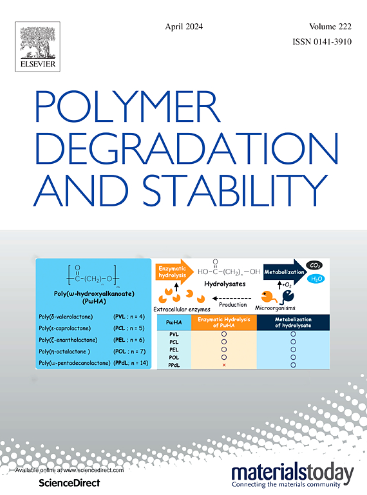In-situ co-precipitation synthesis of Zn/Fe-LDH modified melamine polyphosphate for enhanced flame retardancy in polypropylene
IF 6.3
2区 化学
Q1 POLYMER SCIENCE
引用次数: 0
Abstract
In this study, a novel approach was employed to enhance the flame retardant efficiency of an intumescent flame retardant (IFR) by growing a layered double hydroxides (LDHs) of Zn/Fe on the surface of melamine polyphosphate (MPP), denoted as Zn/Fe-LDH@MPP (LDHMPP). This modification was carried out via in-situ co-precipitation, and the resulting composite was subsequently applied to polypropylene (PP) in conjunction with piperazine pyrophosphate (PAPP). Under the same proportion and concentration, the PP/16 %LDHIFR formulation achieved a preferred V-0 rating in the UL-94 test. Furthermore, this formulation exhibited an enhanced ability to form a protective char layer, as evidenced by both cone calorimetry tests (CCT) and thermogravimetric analysis (TGA) tests. Additionally, the synergistic effect of Zn/Fe-LDH on flame retardancy was also studied.
本研究采用了一种新方法,通过在三聚氰胺聚磷酸酯(MPP)表面生长 Zn/Fe 层状双氢氧化物(LDHs)(称为 Zn/Fe-LDH@MPP (LDHMPP))来提高膨胀型阻燃剂(IFR)的阻燃效率。这种改性是通过原位共沉淀进行的,随后将得到的复合材料与焦磷酸哌嗪(PAPP)一起应用于聚丙烯(PP)。在相同的比例和浓度下,PP/16 %LDHIFR 配方在 UL-94 测试中达到了首选的 V-0 等级。此外,锥形量热试验(CCT)和热重分析(TGA)试验都证明,这种配方形成保护炭层的能力更强。此外,还研究了 Zn/Fe-LDH 对阻燃性的协同效应。
本文章由计算机程序翻译,如有差异,请以英文原文为准。
求助全文
约1分钟内获得全文
求助全文
来源期刊

Polymer Degradation and Stability
化学-高分子科学
CiteScore
10.10
自引率
10.20%
发文量
325
审稿时长
23 days
期刊介绍:
Polymer Degradation and Stability deals with the degradation reactions and their control which are a major preoccupation of practitioners of the many and diverse aspects of modern polymer technology.
Deteriorative reactions occur during processing, when polymers are subjected to heat, oxygen and mechanical stress, and during the useful life of the materials when oxygen and sunlight are the most important degradative agencies. In more specialised applications, degradation may be induced by high energy radiation, ozone, atmospheric pollutants, mechanical stress, biological action, hydrolysis and many other influences. The mechanisms of these reactions and stabilisation processes must be understood if the technology and application of polymers are to continue to advance. The reporting of investigations of this kind is therefore a major function of this journal.
However there are also new developments in polymer technology in which degradation processes find positive applications. For example, photodegradable plastics are now available, the recycling of polymeric products will become increasingly important, degradation and combustion studies are involved in the definition of the fire hazards which are associated with polymeric materials and the microelectronics industry is vitally dependent upon polymer degradation in the manufacture of its circuitry. Polymer properties may also be improved by processes like curing and grafting, the chemistry of which can be closely related to that which causes physical deterioration in other circumstances.
 求助内容:
求助内容: 应助结果提醒方式:
应助结果提醒方式:


